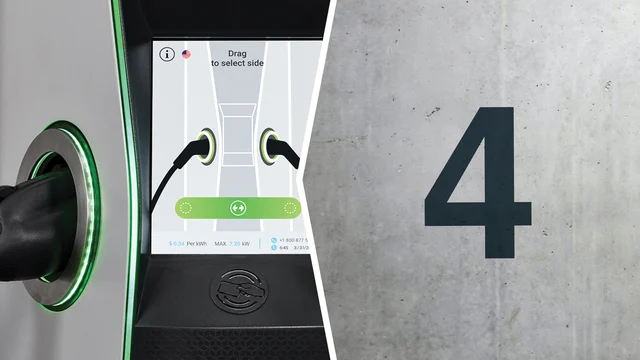Top 5 factors to consider when adding EV charging
EVBox is shaping a more sustainable future where charging your electric vehicle will be as straightforward as finding a parking space, and team members like our North American Business Development Manager, Travis Walker, are steering us in that direction. By 2030, more people will be purchasing electric vehicles than gas-powered ones, according to a report by the Boston Consulting Group earlier this year. Travis helps company leaders understand how investing in EV charging can position you to succeed—and lead—within your market as more people who matter to your business switch to EVs.  Travis Walker Travis became fascinated with renewable energy and its positive impact on both the planet and businesses as he climbed the ranks to senior sales and leadership positions at the country’s top residential solar company. At EVBox, as in his previous role, the satisfaction he gets from his job stems from eliminating obstacles that stand in people's way and helping them achieve their full potential, he says. If you're considering adding EV charging to your location, Travis suggests clearing the path toward a purchase decision by first understanding these five key factors: The number one obstacle preventing gas car drivers from switching to EVs is what Travis calls "range anxiety." Drivers worry about not finding a charging station when needed or that the charger they find won't work for their EV—or won't work at all. This is why reliability is crucial. As a business, it's important to invest in a charger that works with all types of EVs—like the new EVBox Iqon Level 2 charger. This universality, built into Iqon, ensures you can serve all EV drivers, rather than excluding some. Also, check the charger's track record: Does it have a reputation for reliable performance—or for breaking down? It's essential to choose a reliable charging station from a dependable company known for prompt, helpful customer service, Travis notes. To cater to EV drivers, the ideal ratio is one public EV charging station for every four EVs on the road. Currently, there aren't enough EV charging stations in the U.S. to meet the growing number of EV drivers. The current gap stands at 300,000 charging stations and is expected to widen to 1.3 million by 2025. To determine the number of chargers you should install, research the gap in your area: how many EVs are being sold in your city or state? Compare those figures to maps of EV charging stations nearby. If you're an employer, survey your employees to find out how many own EVs, plan to buy them, or would buy them if they knew they could charge at work. EVBox experts are available to guide you on the ideal number of charging stations for your site, based on your location and your company or business type. "A basic guideline I've been sharing with my clients is that if you have more than 100 total parking spaces, you need to aim for at least 10% of those being dedicated to EV charging," Travis says. "We know that if you don't build that level of infrastructure, you could be in trouble down the road, with EV drivers going elsewhere, and companies missing out on the revenue they could've earned from charging these people to park." As more people switch to EVs, places that offer sufficient reliable charging—including shopping centers, restaurants, and workplaces—are the places that drivers will prioritize visiting daily. Just as gas car drivers often plan their commutes to pass by a gas station (for when they need a fill-up), EV drivers seek out routes and locations in their communities that feature accessible charging stations. "If you're one of the first in your market to provide enough charging stations for people in your area, you can be the first to tell them: ‘Come park and charge here,’ and you'll see people start to adjust their routines just to visit your EV chargers," Travis says. The decision about where to place EV charging stations on your site boils down to two factors: power and visibility. Charging stations need to be connected to a power source. Running conduit over a long distance between a charging station and its power source will increase costs. "The closer you can get the charging station to the power source, the better," Travis says. Your EV parking spots also need to be highly visible so drivers can easily spot them as they pull in. Gas car drivers just need to see that you have parking, period, Travis notes. EV drivers need to know immediately upon arrival that they can charge while they park, shop, dine, or visit your business. EV charging stations that are prominently located at your site also signal to your customers and guests that you are environmentally conscious and forward-thinking. They might even inspire gas car drivers to consider an EV for their next vehicle. Some charging companies require that you use and stay loyal to one specific network provider for running your charging stations. Others, like EVBox, offer the freedom to choose and change. With Open Charge Point Protocol (OCPP) interoperability as a core feature of all EVBox charging stations, including the new EVBox Iqon, users can select the right hardware and software combination for their needs and switch their EV charging network at any time without replacing their hardware. Choosing a "software agnostic" brand like EVBox can save you time, frustration, and significant costs, Travis explains. If you're not locked into one company's software, you can avoid being held back if their service no longer meets your needs, their fees suddenly rise, or they go out of business. You can simply switch to a new software platform without having to buy and install new charging stations. Offering customers the ability to choose among software vendors also fosters competition in the market, encouraging innovation and keeping prices fair. The freedom and flexibility that OCPP interoperability provides to customers is so important to EVBox that we are a founding member and the first certified hardware manufacturer of the Open Charge Alliance. Charging stations operate outdoors and interact with people and vehicles throughout the day. To maximize the value of your charging stations, Travis advises considering the durability and longevity of the brand you install. A charger needs to withstand all kinds of weather. It should be able to take a hit and continue charging safely. EVBox Iqon has a rugged and weatherproof exterior, with a steel and aluminum structure that makes it shockproof as well. Another way to think about value in EV charging is to consider longevity, both in the product and the company you buy it from, Travis says. At EVBox, Travis joined a company that had already equipped its hometown of Amsterdam with a comprehensive network of public EV charging. Over ten years, EVBox has installed more than 200,000 charging ports for EVs around the world, including in the U.S. and Canada. With the new Iqon, EVBox has created a flexible and user-friendly charging station designed to meet the needs of your customers, guests, and employees for years to come. Discover everything you need to know about EV charging Download our free ebook to learn why EV charging will set your business apart, help you earn additional revenue, and prepare your location for the transition to electric transportation. keg yeast brink,yeast brink keg,propagation keg,propagation keg,yeast propagation tank Wenzhou Deli Machinery Equipment Co., Ltd. , https://www.sungoodtech.com
Business Development Manager
North America

1. Reliability

2. The right number of charging stations

3. Station placement

4. Network flexibility

5. Long-term value
 hbspt.cta._relativeUrls=true;hbspt.cta.load(3950862, 'a4dca3e6-a0d5-459e-b696-8dffdc590b7d', {"useNewLoader":"true","region":"na1"});
hbspt.cta._relativeUrls=true;hbspt.cta.load(3950862, 'a4dca3e6-a0d5-459e-b696-8dffdc590b7d', {"useNewLoader":"true","region":"na1"});
